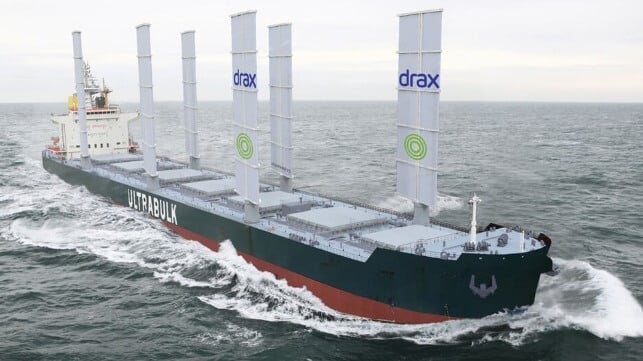Scotland and Industry Fund R&D for Demonstration of Wing Sail Tech

A new effort is getting underway with the support of the Scottish Government and industry leaders including Lloyd’s Register to research and develop wing sail technology that can be retrofitted to in-service merchant ships. The three-year project seeks to undertake a demonstration on a commercial ship by 2023 while also addressing the barriers to the deployment of the technology.
The company called Smart Green Shipping, launched in 2014, has been working on developing its automated sail technology along with supporting digital routing software that analyses the wind to harness the power to deliver fuel and emissions savings to the ship. According to the company, a feasibility study was conducted in 2018 as part of the effort to overcome obstacles to the adoption of the technology. Working with the European Space Agency business incubation center in 2019, they also developed digital tools to predict and optimize wind use in shipping.
SGS did not provide specifics on the design but illustrations show that the sails would fold down similar to other concepts being developed to reduce obstructions and interference with loading and unloading. The sails when raised would also pivot to maximize the contribution to propulsion.
Several similar projects are underway across the shipping industry studying the use of rigid sails to assist propulsion. So far, rotors have been the primary technology deployed for wind-assisted propulsion while several prototypes of sails are also under development. Japan’s Mitsui O.S.K. Lines working with the Oshima Shipyard recently completed installing a telescoping rigid sail on a bulker currently under construction. They plan to begin tests and enter service by October of this year.
“Shipping has a long history of harnessing the power of wind, but digital technologies are allowing us to work towards making zero-emission vessels a reality,” said Diane Gilpin, founder of SGS. “Smart Green Shipping's FastRig wing sail technology offers a financially and technically robust solution to help support shipping’s green transition.”
The project will commence with initial tests of FastRig wing sails at a land-based site at Peel Ports Hunterston Port and Resource Centre in collaboration with Clyde-based specialist engineering partner Malin. They will also further develop the weather routing TradeWind software that creates route plans for wind optimization. The project will also address barriers to wider industry uptake of the technology, with a host of technical, digital, and financing solutions. Following successful land-based tests, a demonstration on board a vessel is expected to be undertaken by 2023.
Lloyd’s Register will participate in the project building on its initial review of the FastRig technology, and its ability to augment a ship's powertrain. “We have successfully completed the first
stage of Approval in Principle of the technology,” said Tom Wolodarsky, Technical Authority for Wind Propulsion Systems, Lloyd’s Register, noting “which can assist in providing assurance to
industry and demonstrate WAPS technology is a safe, viable option that follows well
established, independent standards.”
Modeling tests, undertaken by SGS in conjunction with the University of Southampton’s Wolfson Unit, show that the technology could create at least 20 percent fuel savings and GHG reductions for retrofits, with as much as 50 percent fuel savings possible for small and medium-sized new build ships. According to the company, its analysis shows that the FastRig technology is expected could be deployed on up to 40,000 vessels in the global merchant fleet, primarily bulkers and tankers.

that matters most
Get the latest maritime news delivered to your inbox daily.
The R&D project is being supported with a total funding grant of approximately $6 million, including $3.8 million from industry partners. Scottish Enterprise, Scotland’s national economic agency, is also providing a $2.2 million grant.
